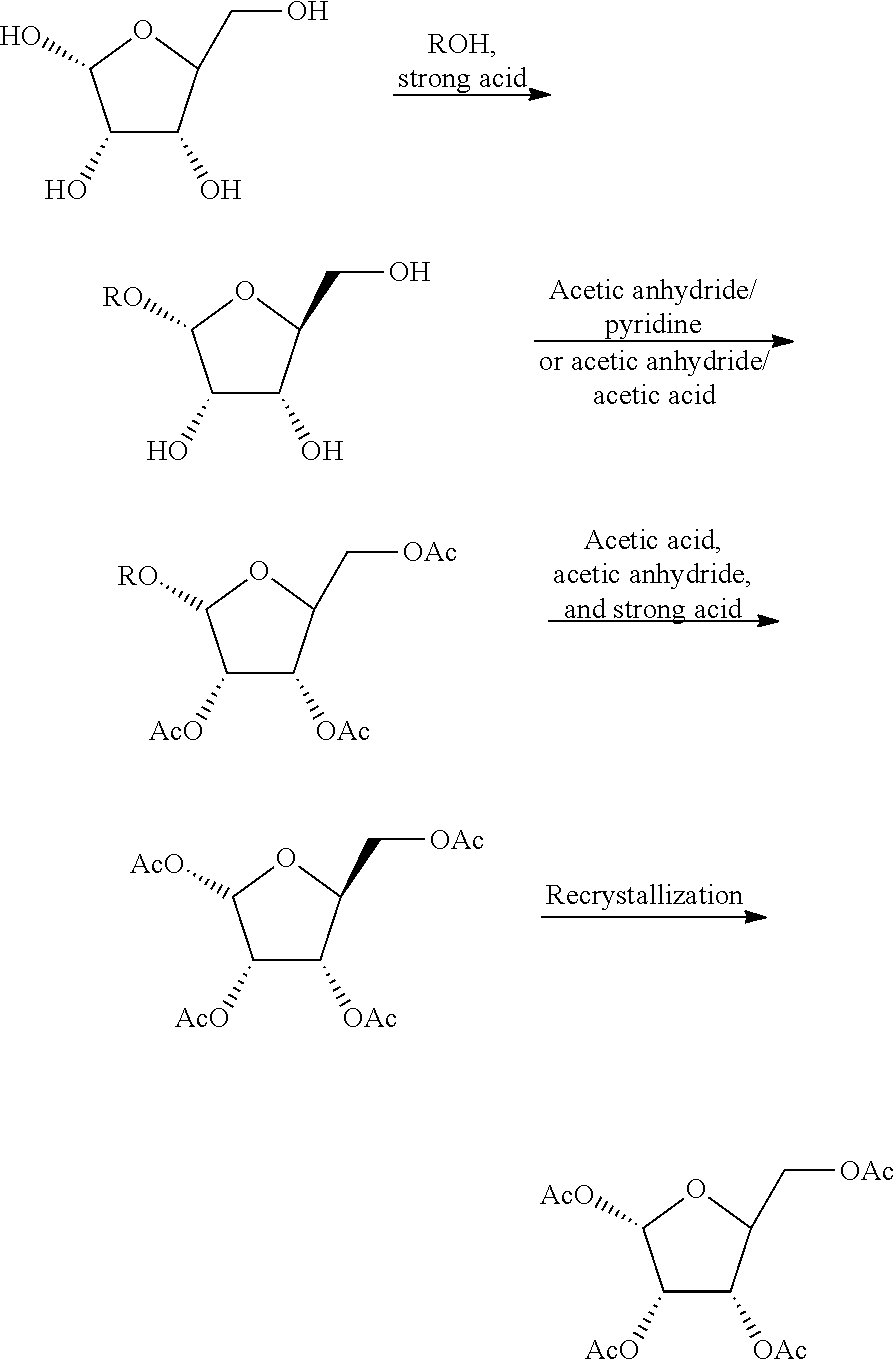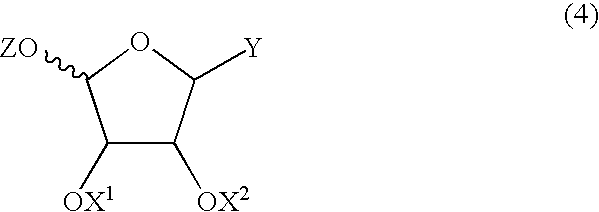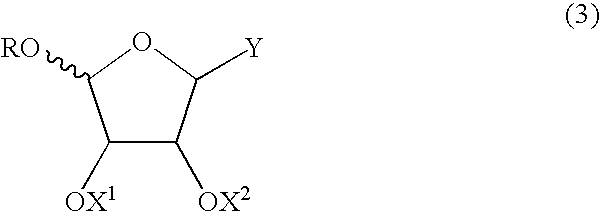Method for producing furanose derivative
a technology of furanose and derivatives, which is applied in the direction of sugar derivates, esterified saccharide compounds, drug compositions, etc., to achieve the effect of high yield
- Summary
- Abstract
- Description
- Claims
- Application Information
AI Technical Summary
Benefits of technology
Problems solved by technology
Method used
Image
Examples
examples
[0079]The following Example A1 and Comparative example A1 are given as synthetic examples of 1-O-acetyl-2,3,5-tri-O-benzoyl-β-L-ribofuranose.
example a1
(1) Synthesis of 1-O-methyl-L-ribofuranose
[0080]L-ribofuranose (20.0 g; 132 mmol) and methanol (226 g) were added to a 1,000-mL flask. Thereafter, concentrated sulfuric acid (1.49 g; 0.11 equivalents) dissolved in methanol (21.2 g) was slowly added dropwise thereto. The obtained mixture was reacted at room temperature for 5 hours. Thereafter, sodium acetate (2.40 g) was added to the reaction product for neutralization, and it was then concentrated under reduced pressure, so as to obtain 31.18 g of crude 1-O-methyl-L-ribofuranose as a whitish oily substance.
[0081]1H-NMR (400 MHz, D2O-d): δ(β-anomer) 3.38 (s, 3H), 3.57-3.62 (m, 1H), 3.76-3.80 (m, 1H), 3.99-4.03 (m, 2H), 4.13-4.16 (m, 1H), 4.89 (d, J=1.0 Hz, 1H) (α-anomer) 3.42 (s, 3H), 3.63-3.75 (m, 2H), 3.98-4.11 (m, 3H), 4.98 (d, J=4.5 Hz, 1H)
(2) Synthesis of 2,3,5-tri-O-benzoyl-1-O-methyl-L-ribofuranose
[0082]31.18 g of the crude 1-O-methyl-L-ribofuranose synthesized in (1) above, toluene (175 ml), a 25 wt. % sodium hydroxide aqueou...
example b1
(1) Synthesis of 2,3,5-tri-O-acetyl-1-O-methyl-L-ribofuranose
[0089]A 500-ml four-necked flask was subjected to nitrogen substitution. Thereafter, 60.0 g (400 mmol) of L-ribose and 300 ml of methanol were added to the flask, and they were then cooled to 5° C. under ice bath cooling. Thereafter, 5.60 g of concentrated sulfuric acid was added to the resultant mixture. Subsequently, the temperature of the mixture was increased to room temperature, followed by stirring for 4 hours. Thereafter, 14.7 g of sodium acetate was added to the reaction solution, and the obtained mixture was then stirred for 30 minutes. Methanol was distilled away from the reaction mixture under reduced pressure, and 120 ml of acetic acid was then added thereto and was subjected to reduced-pressure distillation. It was confirmed by NMR that no methanol remained, and that 1.7 equivalents of acetic acid remained with respect to the ribose derivative. The reaction product was directly subjected to the subsequent proc...
PUM
| Property | Measurement | Unit |
|---|---|---|
| solubility | aaaaa | aaaaa |
| solubility | aaaaa | aaaaa |
| temperature | aaaaa | aaaaa |
Abstract
Description
Claims
Application Information
 Login to View More
Login to View More - R&D
- Intellectual Property
- Life Sciences
- Materials
- Tech Scout
- Unparalleled Data Quality
- Higher Quality Content
- 60% Fewer Hallucinations
Browse by: Latest US Patents, China's latest patents, Technical Efficacy Thesaurus, Application Domain, Technology Topic, Popular Technical Reports.
© 2025 PatSnap. All rights reserved.Legal|Privacy policy|Modern Slavery Act Transparency Statement|Sitemap|About US| Contact US: help@patsnap.com



